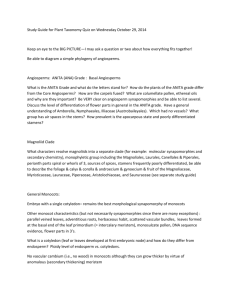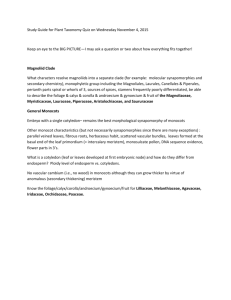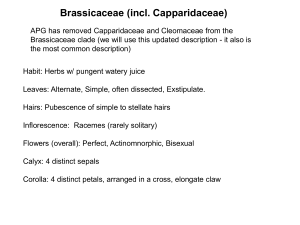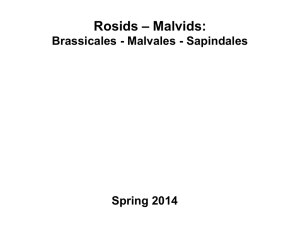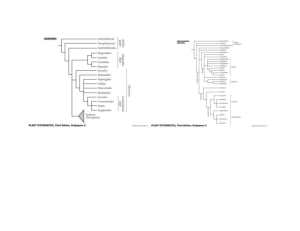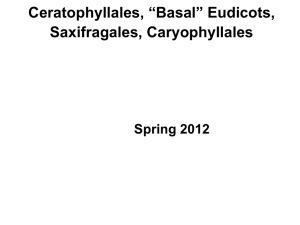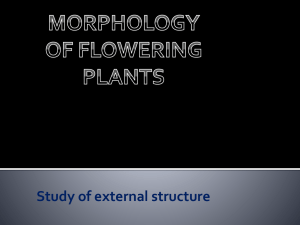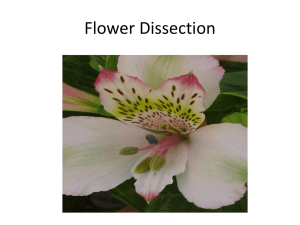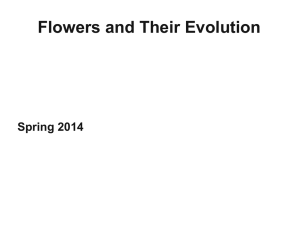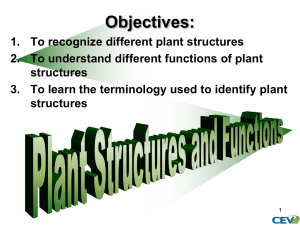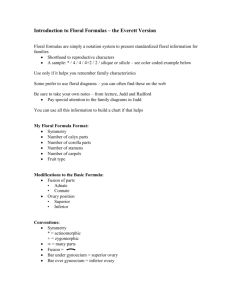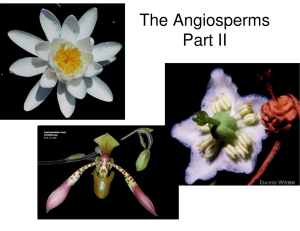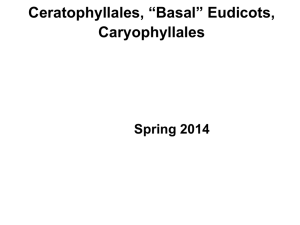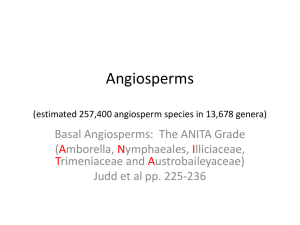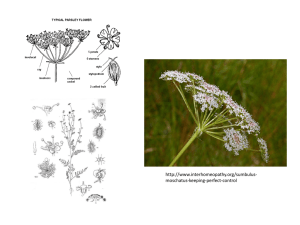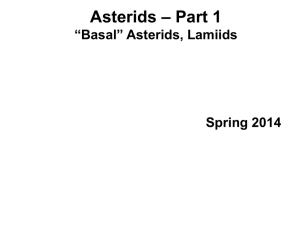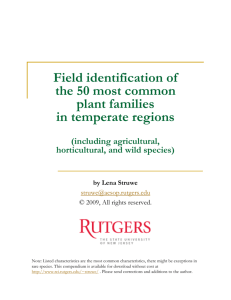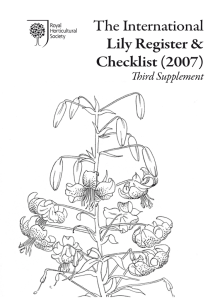Study Guide for Plant Taxonomy Quiz on Wednesday Nov 12
advertisement
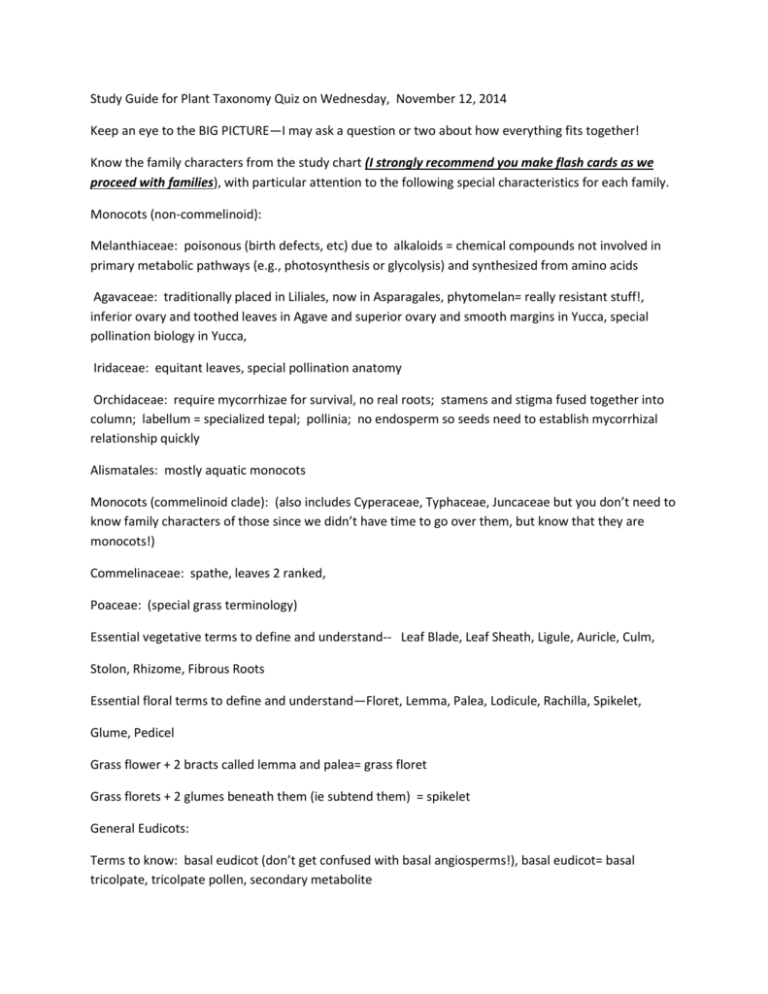
Study Guide for Plant Taxonomy Quiz on Wednesday, November 12, 2014 Keep an eye to the BIG PICTURE—I may ask a question or two about how everything fits together! Know the family characters from the study chart (I strongly recommend you make flash cards as we proceed with families), with particular attention to the following special characteristics for each family. Monocots (non-commelinoid): Melanthiaceae: poisonous (birth defects, etc) due to alkaloids = chemical compounds not involved in primary metabolic pathways (e.g., photosynthesis or glycolysis) and synthesized from amino acids Agavaceae: traditionally placed in Liliales, now in Asparagales, phytomelan= really resistant stuff!, inferior ovary and toothed leaves in Agave and superior ovary and smooth margins in Yucca, special pollination biology in Yucca, Iridaceae: equitant leaves, special pollination anatomy Orchidaceae: require mycorrhizae for survival, no real roots; stamens and stigma fused together into column; labellum = specialized tepal; pollinia; no endosperm so seeds need to establish mycorrhizal relationship quickly Alismatales: mostly aquatic monocots Monocots (commelinoid clade): (also includes Cyperaceae, Typhaceae, Juncaceae but you don’t need to know family characters of those since we didn’t have time to go over them, but know that they are monocots!) Commelinaceae: spathe, leaves 2 ranked, Poaceae: (special grass terminology) Essential vegetative terms to define and understand-- Leaf Blade, Leaf Sheath, Ligule, Auricle, Culm, Stolon, Rhizome, Fibrous Roots Essential floral terms to define and understand—Floret, Lemma, Palea, Lodicule, Rachilla, Spikelet, Glume, Pedicel Grass flower + 2 bracts called lemma and palea= grass floret Grass florets + 2 glumes beneath them (ie subtend them) = spikelet General Eudicots: Terms to know: basal eudicot (don’t get confused with basal angiosperms!), basal eudicot= basal tricolpate, tricolpate pollen, secondary metabolite Tricolpate pollen = best morphological synapomorphy of eudicots Other eudicot characteristics (but again there are exceptions) : two cotyledons, reticulate venation, flower parts in 4 or 5’s, vascular bundles arranged into vascular cambium, taproot. Be able to compare and contrast general eudicot characters vs. general monocot characters. Basal Eudicots (NOT a clade): Ranunculaceae: diverse family but generally superior apocarpous gynoecium and androecium with many distinct stamens Berberidaceae: parts in 6’s even though Eudicots, anthers open by upward turning flaps, what is a staminode and how does it relate to Berberidaceae Papaveraceae: contain various alkaloids (eg morphine), caducous sepals in Argemone, Platanaceae: trees, multiple of achenes, inconspicuous flowers in unisexual flowerheads Core Eudicots: Caryophyllales: composed of 2 main clades, one of which contains betalain pigments and one of which contains anthocyanin pigments. Plants contain either betalains or anthocyanins, but NEVER both. Cactaceae: CAM metabolism (allows stomata to be open at night and closed during the day to conserve water; like C4, malate is the early detectable product of carbon fixation); many touch sensitive stamens, several connate carpels usually inferior, betalains, true leaves are small and caducous Family Foliage Calyx Corolla Androeciu m Gynoeciu m Fruit 6 mostly distinct tepals 6 mostly distinct tepals usually 6 distinct stamens capsule leaves smooth with marginal fibers in Yucca; leaves toothed in Agave Equitant (& conduplicat e) 6 distinct tepals 6 distinct tepals 6 distinct stamens 3-10 connate carpels, usually 3 distinct styles; superior to slightly inferior 3 connate carpels; ovary superior in Yucca, inferior in Agave 6 tepals, inner somewhat differentiate d from outer 6 tepals, inner somewhat differentiate d from outer Three connate carpels, inferior ovary Loculicidal capsule Roots strongly mycorrhizal , parallel venation and sheathing at the base 6 Tepals, inner 3 and outer 3 somewhat differentiate d, one of the inner ones forming the labellum 6 Tepals, inner 3 and outer 3 somewhat differentiate d, one of the inner ones forming the labellum Three distinct filaments, specialized pollination anatomy stamens fused to stigma forming a column; pollen forming masses called pollinia ovary inferior, 3 carpels, stigma highly modified capsule/minut e seeds; seeds lacking endosperm Monocots (nonCommelinoid Clade) Melanthiaceae poisonous alkaloids often present (hence the “Death Camas Family”!) Agavaceae Iridaceae Orchidaceae loculicidal capsule, seeds with black phytomelan crust Foliage Calyx Corolla Androeciu m Gynoecium Fruit Ranunculacea e variable (simple or compound, but usually pinnate or palmate venation) Usually 4 or 5 distinct sepals Usually 4 or 5 distinct petals stamens numerous with distinct filaments carpels distinct, 5 to numerous achene (berry or follicle in other genera than Ranunculus ) Papaveraceae lobed/dissecte d 2 quickly deciduous sepals (caducous) 6 petals many stamens, can be distinct or connate superior ovary, 2 connate carpels (syncarpou s gynoecium ) capsule Berberidaceae Leaves spinoseserrate 6 distinct sepals 6 outer petals and 6 inner petals that are probably really petallike staminodes (staminode = sterile stamen) 6; anthers opening by flaps that open from the base Superior ovary, one carpel, capitate stigma Berry Platanaceae Trees, lobed leaves, toothed Flowerhead s unisexual, flowers very reduced, in globose heads, 3-7 Flowerhead stamens 3s unisexual, 7, filaments flowers very very short reduced, in globose heads, 3-7 superior ovary with 5-9 distinct carpels multiple of achenes (follicles, drupes or others in other Family Basal Eudicots (NOT a clade) minute petals and sepals Family minute petals and sepals genera that Platanus) Foliage Calyx Corolla Androecium Gynoecium Fruit succulent, spiny stems, leaves reduced and falling quickly; Tepals numerous, distinct and petallike Tepals numerous, distinct and petallike numerous distinct touch sensitive stamens Caryophyllales Cactaceae long ovary becoming inferior with 3 to numerous connate carpels Berry; seeds arillate leaves, short spines and glochids; betalains present Plant Taxonomy Plant ID list 2014: WEEK 1 Euphorbia (term to know: cyathium) EUPHORBIACEAE Tribulus (terms to know: schizocarp, mericarp, opposite, alternate, distinct, adnate, connate) ZYGOPHYLLACEAE WEEK 2 Ipomopsis (term to know: exserted) POLEMONIACEAE Castilleja (term to know: hemiparasite) OROBANCHACEAE Malva (term to know: monadelphous) MALVACEAE Hesperidanthus (terms to know: tetradynamous, silique) BRASSICACEAE Desmodium (term to know: loment) FABACEAE Commelina (term to know: spathe) COMMELINACEAE WEEK 3 Melampodium (terms to know: disc flower, ray flower) ASTERACEAE Argemone (term to know: merosity, plant alkaloids) PAPAVERACEAE Cucurbita (terms to know: pepo, inferior ovary) CUCURBITACEAE Datura (terms to know: salverform, funnelform) SOLANACEAE Oenothera (term to know: inferior ovary) ONAGRACEAE WEEK 4 Agastache (term to know: zygomorphic) LAMIACEAE Dieteria (terms to know: phyllary, achene) ASTERACEAE Scirpus (terms to know: sedge, monocot) CYPERACEAE Thalictrum (term to know: dioecious) RANUNCULACEAE Guilleminia (term to know: bract) AMARANTHACEAE WEEK 5 Persicaria (term to know: ochrea) POLYGONACEAE Typha TYPHACEAE Maclura (term to know: multiple fruit) MORACEAE Boerhavia (term to know: anthocarp) NYCTAGINACEAE Mentha LAMIACEAE WEEK 6 Ericameria (terms to know: discoid, lanate) ASTERACEAE Gutierrezia (term to know: radiate) ASTERACEAE Polanisia CLEOMACEAE Croton (term to know: dioecious) EUPHORBIACEAE Salsola (term to know: whole plant is dispersal mechanism) CHENOPODIACEAE WEEK 7 Ephedra (term to know: Gnetophyte) EPHEDRACEAE Portulaca (term to know: circumscissile) PORTULACACEAE Mollugo (term to know: whorled) MOLLUGINACEAE Allionia NYCTAGINACEAE Dimorphocarpa BRASSICACEAE Stachys LAMIACEAE
